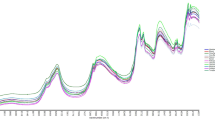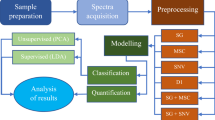Abstract
Japanese black Wagyu beef has its characteristics of fatty well-marbled texture, flavor, and tenderness which are affected by fatty acid composition. The aim of this study was to develop an analytical method for evaluating the fatty acid profile of Wagyu beef by Fourier transform infrared (FTIR) spectroscopy. In the current study, attenuated total reflection–FTIR (ATR-FTIR) spectroscopy and gas chromatography (GC) were applied to the fat tissues, and the solvent-extracted fats which were sampled from subcutaneous, inter- and intramuscular fat tissues. Results of GC analysis showed that monounsaturated fatty acids (MUFA) content became larger in the order of intramuscular, intermuscular, and subcutaneous fats, and saturated fatty acids (SFA) became smaller in the same order. Subcutaneous fat could be discriminated from inter- and intramuscular fats on the basis of fatty acid composition by principal component analysis. The ATR-FTIR analysis revealed that the shift of the peak positions of alkene C–H stretching vibration at around 3,006 cm−1 occurred depending on the unsaturation degree of fatty acids in beef fat. Partial least squares (PLS) regression analysis with leave-one-out cross-validation was applied to the combined regions of 2,800–3,050 and 1,000–1,500 cm−1 for the fat tissues and the extracted fats. The correlation coefficients of the PLS validation models predicting the content of the MUFA and SFA for solvent-extracted fats were higher than those for fat tissues, and the coefficients (R 2) of determination more than 0.873 were obtained for solvent-extracted fats and 0.522 for fat tissues.






Similar content being viewed by others
References
Alexandrakis, D., Downey, G., Scannell, A. G. M. (2009). Rapid non-destructive detection of spoilage of intact chicken breast muscle using near-infrared and Fourier transform mid-infrared spectroscopy and multivariate statistics. Food and Bioprocess Technology, doi: 10.1007/s11947-009-02984.
Alves, M. R., & Oliveria, M. B. (2003). Interpolative biplots applied to principal component analysis and canonical correlation analysis. Journal of Chemometrics, 17(11), 594–602.
AOCS (1989). Official methods and recommended practices of the American Oil Chemists’ Society, 4th edn., official method Ce 1b-89.
Baublits, R. T., Pohlman, F. W. J., Brown, A. H., Johnson, Z. B., Rule, D. C., Onks, D. O., et al. (2009). Correlations and prediction equations for fatty acids and sensory characteristics of beef longissimus rib streaks from forage-fed cattle and retail USDA Choice and Select rib steaks. Journal of Muscle Foods, 20(1), 1–17.
Chen, M., Irudayaraj, J., & McMahon, D. J. (1998). Examination of full fat and reduced fat Cheddar cheese during ripening by Fourier transform infrared spectroscopy. Journal of Dairy Science, 81, 2791–2797.
Christy, A. A., & Egeberg, P. K. (2006). Quantitative determination of saturated and unsaturated fatty acids in edible oils by infrared spectroscopy and chemometrics. Chemometrics and Intelligent Laboratory Systems, 82, 130–136.
Chung, K. Y., Lunt, D. K., Choi, C. B., Chae, S. H., Rhoades, R. D., Adams, T. H., et al. (2006). Lipid characteristics of subcutaneous adipose tissue and M. longissimus thoracis of Angus and Wagyu steers fed to U. S. and Japanese endpoints. Meat Science, 73(3), 432–441.
Folch, J., & Sloane-Stanley, G. H. (1956). A simple method for the isolation and purification of total lipids from animal tissue. The Journal of Biological Chemistry, 226, 497–509.
Fujiwara, Y., Satsuka, A., Tsutsumi, C., Sawada, R., Kaneko, K., Yasuda, F., et al. (2005). Effect of a diet in high oleic acid on plasma lipids in Guinea pigs and humans. Japan Society of Home Economics, 56(3), 171–179.
Gemperline, P. (ed) (2006). Practical guide to chemometrics, 2nd edition, pp 115–118. New York: CRC Press, Taylor & Francis Group
Grundy, S. M., & Denke, M. A. (1990). Dietary influences on serum lipids and lipoproteins. Journal of Lipid Research, 31, 1149–1172.
Guillén, M., & Cabo, N. (1997). Infrared spectroscopy in the study of edible oils and fats. Journal of the Science of Food and Agriculture, 75, 1–11.
Huerta-Leidenz, N. O., Cross, H. R., Savell, J. W., Lunt, D. K., Baker, J. F., Pelton, L. S., et al. (1993). Comparison of the fatty acid composition of subcutaneous adipose tissue from mature Brahman and Hereford cows. Journal of Animal Science, 71, 625–630.
Iñón, F. A., Garrigues, S., & Guardia, M. (2004). Nutritional parameters of commercially available milk samples by FTIR and chemometric techniques. Analytica Chimica Acta, 513, 401–412.
JOCS (1996). Standard methods for the analysis of fats, oils and related materials, Japan Oil Chemist’s Society ed., 2.4.2.1-1996.
Koca, N., Rodriguez-Saona, L. E., Harper, W. J., & Alvarez, V. B. (2007). Application of Fourier transform infrared spectroscopy for monitoring short-chain free fatty acids in Swiss cheese. Journal of Dairy Science, 90, 3596–3603.
Lagrost, L. (1992). Differential effects of cis and trans fatty acid isomers, oleic and elaidic acids, on the cholesteryl ester transfer protein activity. Biochimica et Biophysica Acta, 1124, 159–162.
Lai, Y. W., Kemsley, E. K., & Wilson, R. H. (1995). Quantitative analysis of potential adulterants of extra virgin olive oil using infrared spectroscopy. Food Chemistry, 53, 95–98.
Mandell, I. B., Buchanan-Smith, J. G., & Campbell, C. P. (1998). Effects of forage vs grain feeding on carcass characteristics, fatty acid composition, and beef quality in Limousin-cross steers when time on feed is controlled. Journal of Animal Science, 76, 2619–2630.
Metlon, S. L., Amiri, M., Davis, G. W., & Backus, W. R. (1982). Flavor and chemical characteristics of ground beef from grass-, forage-grain-, and grain-finished steers. Journal of Animal Science, 55, 77–78.
Oka, A., Iwaki, F., Dohgo, T., Ohtagaki, S., Noda, M., Shiozaki, T., et al. (2002). Genetic effects on fatty acid composition of carcass fat of Japanese Black Wagyu steers. Journal of Animal Science, 80, 1005–1011.
Ozutsumi, K., Kawanishi, T., Ito, K., & Yamazaki, T. (1983). Fatty acid composition in various depot fats of fattened Japanese Black and Holstein steers. The Japanese Journal of Zootechnical Science, 54, 470–475.
Ripoche, A., & Guillard, A. S. (2001). Determination of fatty acid composition of pork fat by Fourier transform infrared spectroscopy. Meat Science, 58(3), 299–304.
Safar, M., Bertrand, D., Robert, P., Devaux, M. F., & Genot, C. (1994). Characterization of edible oils, butters and margarines by Fourier transform infrared spectroscopy with attenuated total reflectance. Journal of the American Oil Chemists’ Society, 71(4), 371–377.
Smith, B. C. (1995). Fundamentals of Fourier transform infrared spectroscopy (pp. 55–84). New York: CRC Press.
Smith, S. B., Yang, A., Larsen, T. W., & Tume, R. K. (1998). Positional analysis of triacylglycerols from bovine adipose tissue lipids varying in degree of unsaturation. Lipids, 33, 197–207.
Sturdivant, C. A., Lunt, D. K., Smith, G. C., & Smith, S. B. (1992). Fatty acid composition of subcutaneous and intramuscular adipose tissues and M. longissimus dorsi of Wagyu cattle. Meat Science, 32(4), 449–458.
Waldman, R. C., Suess, G. G., & Brungardt, V. H. (1968). Fatty acid composition of certain bovine tissue and their association with growth, carcass and palatability traits. Journal of Animal Science, 27, 632–635.
Westerling, D. B., & Hedrick, H. B. (1979). Fatty acid composition of bovine lipids was influenced by diet, sex and anatomical location and relationship to sensory characteristics. Journal of Animal Science, 48, 1343–1348.
Windam, W. R., & Morrison, W. H. (1998). Prediction of fatty acid content in beef neck lean by near infrared reflectance analysis. Journal of Near Infrared Spectroscopy, 6, 229–234.
Wise, B. M., Gallagher, N. B., Bro, R., Shaver, J. M., Windig, W., & Koch, R. S. (2006). PLS_Toolbox Version 4.2 for use with MATLAB™ (pp. 167–189). Washington DC: Eigenvector Research, Inc.
Woodcock, T., Fagan, C. C., O’Donnell, C. P., & Downey, G. (2008). Application of near and mid-infrared spectroscopy to determine cheese quality and authenticity. Food and Bioprocess Technology, 1, 117–129.
Yoshida, S., & Yoshida, H. (2003). Nondestructive analyses of unsaturated fatty acid species in dietary oils by attenuated total reflectance with Fourier transform IR spectroscopy. Biopolymers (Biospectroscopy), 70, 604–613.
Acknowledgments
The authors acknowledge the financial support of Grant-in-Aid for Scientific Research, funded by the Japanese Ministry of Education, Science, Sports and Culture and partial experimental assistance by Ms. Kazumi Yoshida. We thank Ito Ham Corp. and the Food Resource Education and Research Center of Kobe University for providing the Japanese Wagyu carcass.
Author information
Authors and Affiliations
Corresponding author
Additional information
Meeting
The 5th International Symposium of the CIGR Section VI ENGINEERING IN BIOPROCESSES held Aug 31st to Sept 2nd, 2009, in Potsdam, Germany.
Source of support
This research was partially supported by the Grant-in-Aid for Scientific Research of the Ministry of Education, Culture, Sports, Science and Technology, Japan, Grant number: (B) 30144603, 2007.
Rights and permissions
About this article
Cite this article
Hu, X., Toyoda, K., Yamanoue, M. et al. Evaluation of Fatty Acid Profile of Wagyu Beef by ATR-FTIR Spectroscopy. Food Bioprocess Technol 3, 883–891 (2010). https://doi.org/10.1007/s11947-010-0375-8
Received:
Accepted:
Published:
Issue Date:
DOI: https://doi.org/10.1007/s11947-010-0375-8




